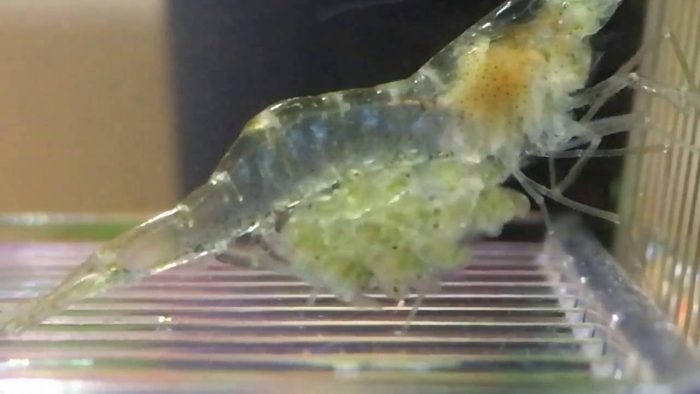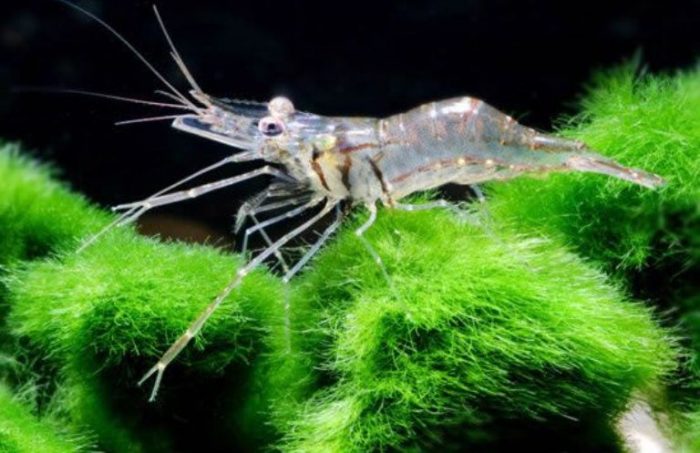The Ghost Shrimp or Glass Shrimp is a very interesting species of shrimp. Their entire body is transparent, and many are fascinated to watch their digestive processes unravel through their transparent shell. They are kept either as pets or as “tasty treats” to be fed to a larger fish. Sadly, they have a very short lifespan, ranging from a few days to a maximum of 1.5 years. This is why Ghost Shrimp breeding should be handled with utmost care to keep the species going.
Table of Contents
How Long Does It Take For Ghost Shrimp Breeding Cycle To Complete?
In Ghost Shrimp breeding, you don’t have to put in a lot of effort as everything happens naturally. Just bring the male and the female together and watch them procreate. Once the female Ghost Shrimp is ready to breed (the owner has provided optimum breeding conditions) and the male is available to fertilize the eggs, you should begin to see pregnant females within 2 weeks after this.
From the moment the eggs are fertilized, the incubation period is between 12 to 14 days before the frys are born alive – if you keep the temperatures at 80 degrees Fahrenheit. Overall, all you need to do is to provide the best environment for the Ghost Shrimp breeding process to thrive.
It is advised to separate pregnant shrimps from the rest of the pack in a separate tank, this is to increase the chances of survival of the frys. If you notice the mother feeding on her young, it is best to separate the mother from the babies as well; just provide food for the frys, with live plants and plenty of hiding places available to them.
What Tank Size Is Perfect For Ghost Shrimp Breeding?
Most of the time, choosing the right tank depends on factors around you, as well as the purpose of the tank. Fish and Shrimp tanks come in all manner of shapes and sizes, and you may choose whichever one suits your fancy or fits your available space, but make sure that the tank for your shrimp is between 5 to 10 gallons of capacity.
For Ghost Shrimp breeding purposes, it is important not to overstock the tank to avoid a high mortality rate or cannibalism. As seen above, these shrimps can turn around and feed on their own so it is best to maintain enough space in the tank. Always make sure that the temperature in the tank is between 72 to 82 degrees Fahrenheit, and not higher. The pH level of the tank should also be between 7.0 to 8.0.
Also, it is important to ensure that there is a constant air bubbles supply in the tank with a continuous flow of water as well, while ensuring optimal aquarium lighting is provided always.

Breeding Conditions To Help The Process
The Ghost Shrimp breeding process is a very challenging one and since they are not being raised in their natural habitat, owners have to assist them in this process. Notwithstanding, there are easy steps to take to make the cycle hitch-free.
The first thing to note is that they flourish in freshwater habitats and in order for them to have a higher chance of reproducing, you have to stock their tank with twice as many female shrimps as the males. Then you need to cultivate natural plants and put artificial rocks for crevices and hide-aways in their tank; this will give them the enabling environment needed to be totally relaxed and encourage them to reproduce. As much as possible, endeavor to create something that looks like the natural habitat of the Ghost Shrimp.
It is believed that raising the temperature of the tank to 80 degrees Fahrenheit, is the optimal state for the Ghost Shrimps breeding process to thrive. This temperature, even though artificially stimulated, would stimulate them to believe that they are in the warmer months, which is the natural Ghost Shrimp breeding period; plus the added advantage that warmer temperatures help to increase the rate of metabolism of the shrimps and equally goes a long way in stimulating their breeding.
Changing the tank water before and during the period of raising the water temperature is also advised, to help promote breeding.
Adding small limestone chips to the filter of the shrimp’s tank will help to increase the hardness of water, which would, in turn, make higher levels of calcium available to the Ghost Shrimp. It needs this for its eggs to mature. You can give the shrimp calcium supplements at this time also to help the process.
What Do Ghost Shrimps Eat?
They are generally classified as omnivores but will eat any edible matter present in their tank – including other Ghost Shrimps.
They will eat naturally existing edible matter such as Algae, and dead plant matter; they will also eat commercially prepared feed such as Algae flakes and wafers, fish, and shrimp pellets. Generally, any leftover food they can find in the tank turns into their food at that moment.
This is partly why they are usually referred to as the “vacuum cleaners” of any tank they are found in, as they can be seen meticulously scavenging throughout the entire tank, eating up everything they can find.
Read Also: How To Breed Turtles: 12 Steps To Follow
These Kinds Of Fish Can Cohabit With The Ghost Shrimp
The Ghost Shrimps are very small in size and care has to be taken to choose other aquatic life forms that cohabit with them peacefully in the same tank or other enclosures. Needless to say, they can easily turn to food for the wrong neighbors.
The general rule of thumb here should be, do not put the Ghost Shrimp in the same tank with other fishes that are either larger than them or whose mouth is big enough to swallow/feed on them. In view of this, they can cohabit with other shrimp breeds like the Amano, Red Cherry, Vampire (not bloodsucking), and the Bamboo shrimps. They can also dwell amicably with snail species such as the Malaysian Trumpet, Ivory, Mystery, Gold Inca, and Ramshorn snails. They can also coexist with catfish species like the Otoncinclus and Cory.
Unless the intention is to use them as feed, you should avoid putting them together with aquatic species like Oscars, Frogs, Crayfish, goldfish, and other Cichlids.
